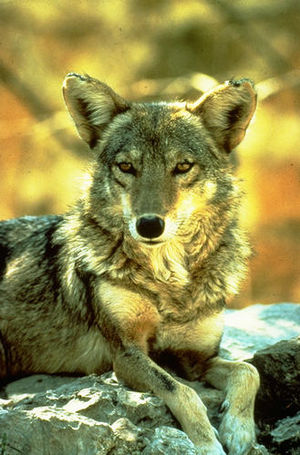Field Guide/Mammals/Coyote
< Field Guide | Mammals
| Canis Latran (Coyote) | |
|---|---|
|
Family: Canidae
Size: Max height of coyote is 18” (45.7 cm). Length is 3 ft (0.9 m). Weight is 25-45 lbs. (11.3-20.4 kg).
Description: Small wolf-like animal. Fur color is variable depending on geographical location and subspecies. Fur colors are usually reddish, black, or gray predominantly. Size is comparable to a smaller full grown Labrador. Looks are comparable to German shepherd or a small wolf.
Similar Species: Coyotes’ ears are pointed and stick straight up, differentiating it from a German shepherd dog which looks similar to the coyote. Coyote looks very similar to wolf but is can be as small as half of a wolf’s length[1]
Range: Ranges from northern Canada to Central America. Found in all United States excluding Hawaii. Do not extend into South America.
Habitat: Live in variety of habitats ranging from forests, to outskirts of cities to tundra.
Diet: Opportunistic feeders and scavengers. Carnivorous, eating anything from fish to insects to deer.
Activity: Coyotes are nocturnal, so they feed at night. They do not hibernate.
Reproduction: Mating season is between January and February. Female picks the male. Once picked, there is little opposition to male. Gestation period is 2 months. Average litter size is 6 cubs. Cubs are born in den already dug by different animal or the parents dig one together. Male provides for the cubs by protecting them and hunting for them. Cubs are weaned by 35 days and are fed regurgitated food from parents. Cubs can begin to hunt by 4 months. Physical maturity reached at 9-12 months.
Lifespan: 10-14 years.
Notes: Coyotes are extremely adaptable and are found in many different types of habitat as long as it has water, food, and cover. Coyotes are known for remaining unnoticed even while living in close proximity to humans. There are very few attacks on humans by coyotes each year. Coyotes generally hunt at night.[1]
Coyotes help keep rodent populations lowered. Their pelts can also still be sold in some places. Coyotes sometimes hunt with badgers when hunting rodents. The coyote chases the rodent above ground and the badger chases the rodent underground, and they come together to share in the spoils in the end. Coyotes prefer fresh meat but have to rely on carrion as a large portion of their diet. Coyotes usually don’t hunt together but will group together to take turns chasing a deer until it tires for the kill or chase it toward a hidden member of the group. Coyotes are the most vocal of all North American mammals. They have various means of communicating sounds but are most known for their long drawn out howl. This howl is to notify other packs that they have already claimed a certain territory. It is also used to reunite with other members of their pack.[2]
|
 |
- ↑ a b Minnesota Department of Natural Resources (2012), Mammals of Minnesota: Coyote, retrieved October 1, 2012
- ↑ Tokar, E (2001), Canis latrans, retrieved October 1, 2012